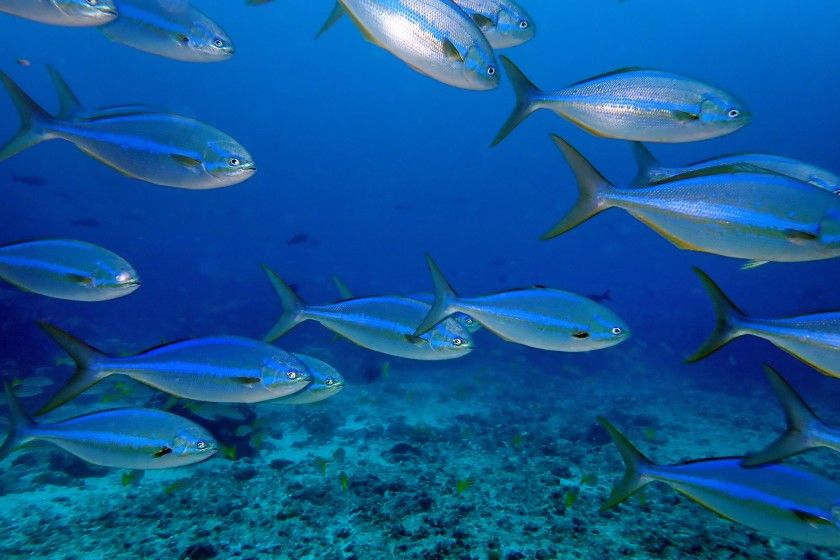[ad_1]
Just south of Galapagos’ Marchena Island is a dive spot known by locals as the “fish arena,” where colorful fish, like these rainbow runners, swim in large schools. (Carolyn Cole / Los Angeles Times)
Six hundred miles west of Ecuador’s coast, the Galapagos Islands are a chain of volcanic islands — some still active — home to some of the world’s richest biodiversity and endemism. Nearly 80% of the species found on the islands aren’t found anywhere else on Earth.
Along the rocky outcrops, marine iguanas bathe in the hot sun before plunging into the cool waters, where they swim alongside Galapagos penguins, and below the soaring, diving blue-footed boobies.
A confluence of oceanic currents meets at the Galapagos, giving rise to the extraordinary richness of wildlife — where southern ocean, cold-water creatures, such as penguins and fur seals, are found alongside equatorial and North Pacific critters, such as sea lions and hammerhead sharks.
On land, the ecosystems range from desert-like to lush and tropical — depending on altitude, wind exposure and geological age of the island. On Santa Cruz Island, for instance, the northern end is rocky, sandy and dry. But ascending the island’s volcano, and to the south, the ecosystem becomes lush and cool. Giant tortoises amble through tall grasses, munching on banana leaves and — to many local farmers’ annoyance — outdoor crops.
It is a crime to hurt or kill a tortoise in the Galapagos — penalties range from the low to high thousands. Car and truck drivers stop to lift tortoises seen crossing roads. Sometimes, however, the tortoises are too big to pick up. So everyone just has to wait.
A local resident stops to remove a Galapagos tortoise from the road on the island of Santa Cruz. (Carolyn Cole / Los Angeles Times)A white-tipped reef shark in the waters off North Seymour Island in the Galapagos. (Carolyn Cole / Los Angeles Times)A juvenile blue-footed booby practices flapping his wings before beginning to fly on North Seymour Island in the Galapagos. (Carolyn Cole / Los Angeles Times)A blue-footed booby tends to her chicks on North Seymour Island in the Galapagos. (Carolyn Cole / Los Angeles Times)With few tourists visiting the Galapagos, a baby sea lion has his first encounter with a human on North Seymour Island. (Carolyn Cole / Los Angeles Times)Frigate birds fly off the Galapagos Islands. The Galapagos Islands are the breeding ground for many species on land and in the sea. (Carolyn Cole / Los Angeles Times)A sea lion rests on a bus stop bench in Puerto Ayora, where tourism is down dramatically due to the pandemic. (Carolyn Cole / Los Angeles Times)Pinnacle Rock is a celebrated volcanic plug on Bartholomew Island, one of Ecuador’s Galapagos Islands. (Carolyn Cole / Los Angeles Times)A red-footed booby sits above a group of iguanas on North Seymour Island, Galapagos. (Carolyn Cole / Los Angeles Times)
This story originally appeared in Los Angeles Times.
[ad_2]
Source link
